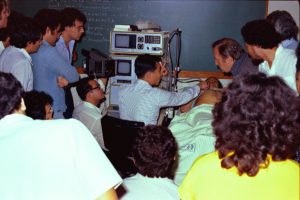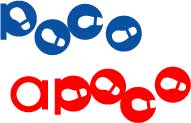About a year after I moved to the Export Department, it began to be said that it is effective for ultrasonic diagnosis, especially in the field of obstetrics and gynecology, for diagnosing fetal development.
In addition, techniques for diagnosing the liver, gallbladder, and pancreas have also been advanced.
Ultrasonography has begun to be evaluated as well as heart and blood flow diagnoses.
One day, when Chief Engineer Nakajima of the Medical Equipment Division came to our senior manager and talked to him, I was called for some reason.
“Mr. Sato, would you like to go to Niigata with Chief Engineer Nakajima?”
I was told.
I knew this chief engineer Nakajima well because he was the manager when I was in the design department of the factory before.
A few days later, I went to Niigata University with Chief Engineer Nakajima and met DR.Seigou Sakaguchi. As I learned later, this doctor seems to have been the top class in ultrasonic diagnosis of the liver, gallbladder, and pancreas in Japan.
In Niigata, I didn’t talk much with this doctor.
It was later discovered that Chief Engineer Nakajima had made various plans to go to Brazil and Argentina with this doctor.
Chief Engineer Nakajima told me.
“Mr. Sato and Dr. Sakaguchi will hold ultrasonic diagnostic seminars in several places in Brazil, so you should talk with the locals.” 
At that time, such seminars were common in Japan, but we had no experience of conducting ultrasonic diagnostic seminars overseas.
However, as I was told, I contacted President Okawa of TMB, a local subsidiary in Brazil.
Of course, I have never held an ultrasound diagnosis seminar in the field, but since TMB is a sales company, he immediately agreed to hold the seminar.
The staff spoke with influential teachers at the University of São Paulo and persuaded them. Therefore, it was decided to hold three seminars on the campus of the University of Sao Paulo and two seminars in Rio de Janeiro.
This DR Sakaguchi entered the Faculty of Engineering at Tohoku University, but re-entered the Faculty of Medicine at Kyushu University. It was later discovered that he was temporarily going to Niigata University to study the liver, gallbladder, and pancreas.
He probably studied English somewhere. He spoke very well in English.
First, DR Sakaguchi diagnoses a patient at the University of Sao Paulo with an ultrasonic device, and explains the details of the diagnosis.
Many doctors do not know what is happening at first, but the doctors who attended immediately evaluated the diagnosis because the diagnosis was accurate.
Then, the doctors there called the sales staff themselves and ordered.
Most of the doctors studying at the University of São Paulo had a clinic, and from the afternoon they were diagnosing patients at their own clinic.
President Okawa, who was watching the scene, saw the effect of this seminar and thanked me that it was amazing.
The seminar we hosted also gained a great reputation in Rio de Janeiro.
After successfully completing the five seminars, we left Rio de Janeiro.
 We headed to Foz do Iguacu, the Iguazu Falls.
We headed to Foz do Iguacu, the Iguazu Falls.
From Rio de Janeiro to the west for about 3 hours by plane, I could see a vast field. And I could see the dark forest.
Iguazu Airport was a small airport, but many tourists came. It took about 30 minutes by taxi from the airport to our hotel.
The three of us walked from the hotel to Iguazu Falls.
It was wonderful to see the water flowing down with a “go-go” noise.
We stayed at Hotel Catalatas, which is right in the woods.
The next day, breakfast was recommended in the garden. As we were eating at the table in the garden, oms and colorful birds approached around the table.
It was my first time to have such a wonderful breakfast.
From there, Chief Engineer Nakajima and DR Sakaguchi flew to Buenos Aires, Argentina, and I returned to Japan via Rio de Janeiro.

横浜こぼれ話は筆者の佐藤栄次が随筆や意見や考えを書いておりますので、一度見に来てください、
%d人のブロガーが「いいね」をつけました。





